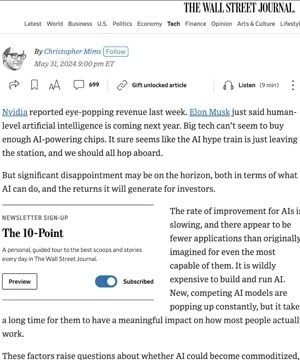What is the AI hype cycle?
Sources:
The AI hype cycle refers to the phases of enthusiasm and subsequent disillusionment surrounding AI technologies. Notable points from experts include:
-
Phases of the Hype Cycle:
- Sarah Guo mentions that many technologies experience hype cycles where a vast majority fail, but the few that succeed can be highly impactful. She points out that timing and correct identification of viable technologies are crucial to benefit from these cycles 1.
- Jordan Wilson explains the traditional stages defined by Gartner: the "innovation trigger," the "peak of inflated expectations," the "trough of disillusionment," the "slope of enlightenment," and the "plateau of productivity." He asserts that generative AI is currently seen as being at the "peak of inflated expectations" according to Gartner 2.
-
AI Versus Other Technologies:
- Vince Hankes contrasts AI's current hype with historical hype cycles of other technologies like crypto and the dot-com bubble. He emphasizes the need to understand the core value AI offers rather than just chasing investment trends 3.
- Elad Gil and Sarah Guo discuss parallels with the blockchain hype cycle, noting that both have phases of significant excitement followed by a realization phase where realistic, sustainable applications emerge 4.
-
Impact of AI Hype:
- Many experts believe that despite the hype, meaningful innovations emerge from these cycles. Examples include technology transitions like mobile apps and social networks where ultimately successful applications like Instagram broke through after initial waves of excitement 1.
- Jordan Wilson argues that generative AI represents a paradigm shift, not just another tech hype. He suggests that AI will continue to evolve significantly and views it as integral to the current economy rather than a passing phase 5.
-
Investor Perspective:
- Both Vince Hankes and Nathaniel Whittemore stress the importance of distinguishing between AI's potential capabilities and the returns it might generate for investors. They highlight that while AI's advancements are substantial, the hype often leads to inflated expectations which might not align with actual financial returns in the near term 3 6.
In summary, the AI hype cycle involves stages of exaggerated expectations followed by disillusionment and eventual stabilization with meaningful applications. Experts underscore the need for careful identification of genuine innovations amidst hype and caution about overestimating immediate financial returns.
RELATED QUESTIONS-


